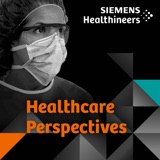
Healthcare Perspectives
Siemens Healthineers
Podcast
Episodes
Listen, download, subscribe
Scaling education to advance health for all
• 30 minAccess to quality healthcare is still out of reach for millions worldwide — particularly in low- and middle-income countries and underserved rural areas. One of the biggest drivers of this gap is a shortage of trained healthcare workers, a challenge made worse by workforce migration, limited local training opportunities, and uneven distribution of resources. In this episode of Healthcare Perspectives, host Hagen Weissapfel, Director of Education and Customer Services for Global Access to Care at Siemens Healthineers, is joined by Melissa Culp, Executive Vice President of Member Engagement at the American Society of Radiologic Technologists (ASRT), and Dr. Geoff Ibbotson, surgeon and Executive Director of the Global Surgery Foundation (GSF). Together, they explore how education and training — scaled through digital innovation and local partnerships — can transform access to care for underserved communities. From stories of practicing in isolation in remote Nepal, to advancing imaging education in Malawi, to building global learning platforms like SURGHub, Melissa and Geoff share how sustainable, in-country solutions can empower healthcare professionals, break down systemic barriers, and save lives. What you’ll learn in this episode: Why education is one of the most sustainable forms of impact in global healthHow digital learning platforms like SURGHub are connecting providers in over 200 countriesThe role of local leadership and trust in building effective training programsHow public awareness campaigns can inspire the next generation of medical imaging professionalsThe life-or-death consequences of gaps in surgical technology access — and how training can close themWhy small, targeted investments can yield measurable improvements in health outcomes Connect with Hagen Weissapfel LinkedIn Connect with Melissa Culp LinkedIn Connect with Geoff Ibbotson LinkedIn Hosted on Acast. See acast.com/privacy for more information.
Healthcare Perspectives RSS Feed

